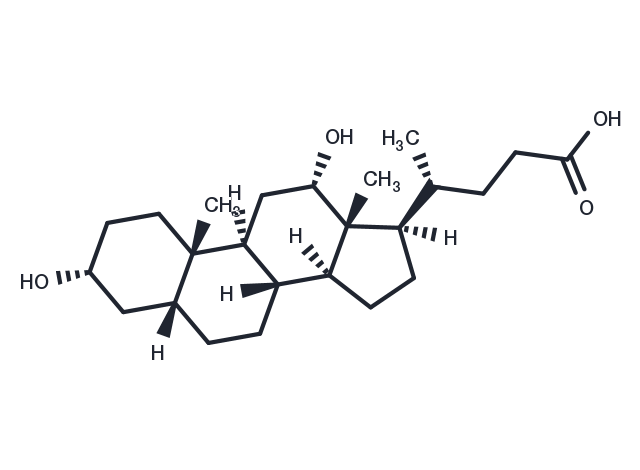Powder: -20°C for 3 years | In solvent: -80°C for 1 year


Deoxycholic acid (Cholanoic Acid) is a bile acid formed by bacterial action from cholate. It is usually conjugated with glycine or taurine. Deoxycholic acid acts as a detergent to solubilize fats for intestinal absorption, is reabsorbed itself, and is used as a choleretic and detergent.

| Pack Size | Availability | Price/USD | Quantity |
|---|---|---|---|
| 100 mg | In stock | $ 53.00 | |
| 500 mg | In stock | $ 72.00 | |
| 1 mL * 10 mM (in DMSO) | In stock | $ 57.00 |


| Description | Deoxycholic acid (Cholanoic Acid) is a bile acid formed by bacterial action from cholate. It is usually conjugated with glycine or taurine. Deoxycholic acid acts as a detergent to solubilize fats for intestinal absorption, is reabsorbed itself, and is used as a choleretic and detergent. |
| In vitro | Deoxycholic acid inhibits miR-21 expression in primary rat hepatocytes in a dose-dependent manner, and increases miR-21 pro-apoptotic target programmed cell death 4 (PDCD4) and apoptosis. Deoxycholic acid decreases NF-κB activity, shown to represent an upstream mechanism leading to modulation of the miR-21/PDCD4 pathway[1]. |
| In vivo | miR-21 expression is down-regulated upon short exposures to Deoxycholic acid, as is the downstream pathway, with concomitant PIDD processing and activation of caspase-2, which contributes to DCA-induced liver damage[1]. |
| Cell Research | Primary rat hepatocytes were isolated from male rats (100 to 150 g) by collagenase perfusion. After isolation, hepatocytes were resuspended in complete Williams E medium and plated on BD Primaria™ culture dishes at 5 × 104 cells/cm2. Cells are kept at 37 °C in a humidified atmosphere of 5% CO2 for 4-6 h to allow attachment. Plates are then washed with phosphate buffered saline (PBS) 1× in order to remove dead cells and incubated in Williams E medium supplemented with 25 to 200 μM DCA or no addition (control) for 24 h. Primary rat hepatocytes are processed for total RNA and protein isolation, cell viability, cytotoxicity and caspase activity assays and Hoechst staining. (Only for Reference) |
| Synonyms | Cholorebic, Deoxycholate, Desoxycholic acid, Cholanoic Acid, Cholerebic |
| Molecular Weight | 392.57 |
| Formula | C24H40O4 |
| CAS No. | 83-44-3 |
Powder: -20°C for 3 years | In solvent: -80°C for 1 year
DMSO: 72 mg/mL (183.4 mM)
Ethanol: 56 mg/mL (142.6 mM)
H2O: < 1 mg/mL (insoluble or slightly soluble)
You can also refer to dose conversion for different animals. More
bottom
Please see Inhibitor Handling Instructions for more frequently ask questions. Topics include: how to prepare stock solutions, how to store products, and cautions on cell-based assays & animal experiments, etc.
Deoxycholic acid 83-44-3 GPCR/G Protein Metabolism GPCR19 Endogenous Metabolite TGR5 Cholorebic G-protein coupled receptor 19 G protein-coupled Bile Acid Receptor 1 GPBAR1 Deoxycholate G protein-coupled bile acid receptor bile acid Desoxycholic acid inhibit Cholanoic Acid Inhibitor Cholerebic inhibitor
